By: Hayley Robb Price
Japan was a trip my husband always wanted to take. So, we booked a plane ticket and planned a 10-day adventure in Tokyo, Kyoto, and Osaka, Japan.
As the self-proclaimed water nerd in our household, I had to add the Tokyo WaterWorks Historical Museum to our itinerary.
In my first year at Louisville Water, the Louisville Water Tower has become a large part of my role. From social media management and planning special events, learning the 165-year history of Kentucky’s first water provider has been one of the highlights.
So, when presented with an opportunity to explore another city’s origin story, I was all in. Spoiler alert: Our stories are not too different after all.
From Wells to WaterWorks
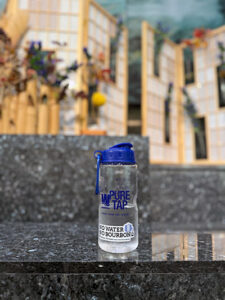 When people think of great cities, they often think of their skylines or culture. But a city’s truest measure of progress lies in something far more fundamental: its water.
When people think of great cities, they often think of their skylines or culture. But a city’s truest measure of progress lies in something far more fundamental: its water.
Though oceans apart, Louisville, Kentucky and Tokyo, Japan share remarkably similar origin stories – tales of innovation born from public health crises, civic pride, and the belief that access to clean water can shape a city’s future.
In Louisville, the mid-19th century was a turning point. Outbreaks of cholera and typhoid made clear that wells and river water were no longer safe sources. Louisville had a nickname in the early 1800s. It was thought of as the “graveyard of the West” because settlers were dying in Louisville before they made it out west.
However, it actually wasn’t disease that sparked the need for a water company in Louisville. It was fire protection.
In 1840, Louisville experienced a great fire that nearly destroyed all downtown businesses. Cisterns hooked up to a water supply proved to be a much more effective way to fight fires than the original “bucket brigade.”
In 1854, the Louisville Water Company was chartered, and within a few years, the city broke ground on a bold project: Louisville WaterWorks along the Ohio River.
Prior to 1860, people would get water from private wells on their property, or they’d grab a bucket and get it right from the river themselves.
The same was true in Tokyo. Wells were the way of the world before a WaterWorks.
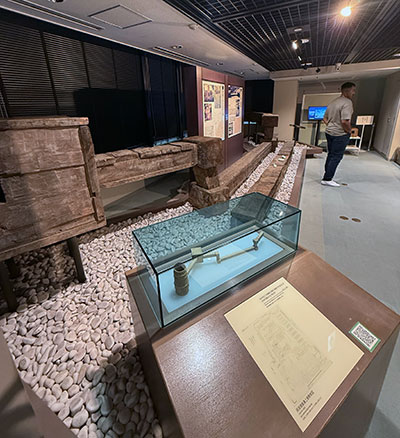 Tokyo (then referred to as “Edo”) had been experimenting with water systems since the 1600s. The Konda Josui and Tamagawa Aqueducts carried clean water from distant rivers into the bustling city via hand-dug channels and wooden pipes, impressive engineering feats that were actually on display in the museum!
Tokyo (then referred to as “Edo”) had been experimenting with water systems since the 1600s. The Konda Josui and Tamagawa Aqueducts carried clean water from distant rivers into the bustling city via hand-dug channels and wooden pipes, impressive engineering feats that were actually on display in the museum!
By the late 1800s, rapid modernization and population growth brought new challenges. Open canals were no match for the needs of a modern capital. By 1898, Tokyo opened the Yodobashi Purification Plant, launching Japan’s first Western-style water treatment system.
During that same time, George Warren Fuller was conducting landmark filtration experiments on the grounds of the Louisville Water Tower that would later be adopted by the rest of the world.
Like Louisville, Tokyo also faced great challenges when it came to disease and natural disasters. Cholera made its way to Tokyo in the 1880s, proving the need for a safe and sanitary water supply.
While Louisville faced tornadoes and flooding, Tokyo faced earthquakes and droughts. The tornado of 1890 in Louisville split the water tower in half at the balustrade and was later rebuilt out of metal instead of wood.
In 1920, Tokyo experienced the Great Kanto Earthquake, in which its WaterWorks faced much damage, too.
No matter the adversity, both cities showed great resilience throughout the decades.
Civic Beauty Meets Engineering Brilliance
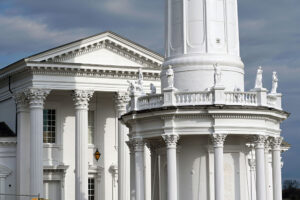
Both cities understood that water infrastructure was more than just pipes and pumps – it could be art, pride, and legitimacy.
For Louisville Water, founders Theodore Scowden and Charles Hermany were selling a product many didn’t believe in. So, they wanted the structures to bring confidence to the people. The original Pumping Station and Water Tower feature many iconic Classical motifs, including fluted Corinthean columns, acanthus leaves, and egg and dart molding.
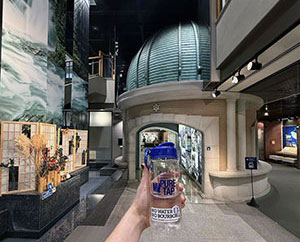 In Tokyo, design was also very important. Upon entering the Tokyo WaterWorks Historical Museum, one of the first things you see is a life-size replica of the Murayama Reservoir intake tower. This architecture is characterized by a Neo-Renaissance style, featuring a round domed roof with copper sheets, tiled exterior walls, and arched windows. Many describe the tower to look as if it’s floating on the lake.
In Tokyo, design was also very important. Upon entering the Tokyo WaterWorks Historical Museum, one of the first things you see is a life-size replica of the Murayama Reservoir intake tower. This architecture is characterized by a Neo-Renaissance style, featuring a round domed roof with copper sheets, tiled exterior walls, and arched windows. Many describe the tower to look as if it’s floating on the lake.
Another symbol often found in Japanese culture is the dragon. Many water fountains are dragon-shaped because dragons symbolize protection, wisdom, and the power of nature. The dragon’s connection to water makes it a fitting guardian or deity.
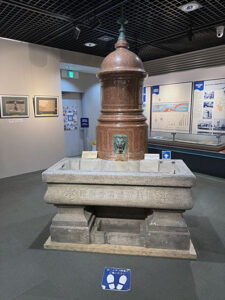
Water fountains served multiple purposes in Tokyo, too. One side would feature a large trough for horses, while the other side would feature a small fountain for humans. Louisville Water has similar archived images of water fountains in the community. Horses were integral in the early days at Louisville Water. They were even used for sprinkling the dirt streets in the 19th century. So, keeping them hydrated was key!
The Commitment They Share
Though they developed half a world apart, Louisville and Tokyo tell the same story: public health drives innovation and the quest for clean water is one of the greatest collaborations.
Both continue to preserve their history through impressive museums, inviting the community to learn more and celebrate the innovation that got us to present day.
Today, Louisville Water serves nearly one million Kentuckians. Tokyo serves nearly 14 million people. Despite their difference in service area, both cities are committed to establishing trust in their product and reminding us that progress can start with something as simple and vital as a clean glass of water.
You’re in luck! You don’t have to travel to Tokyo to learn about the quest for clean water, join us for our next community open date on Sunday, November 9 from 12-5 p.m. Learn more about the WaterWorks Museum at LouisvilleWaterTower.com.

